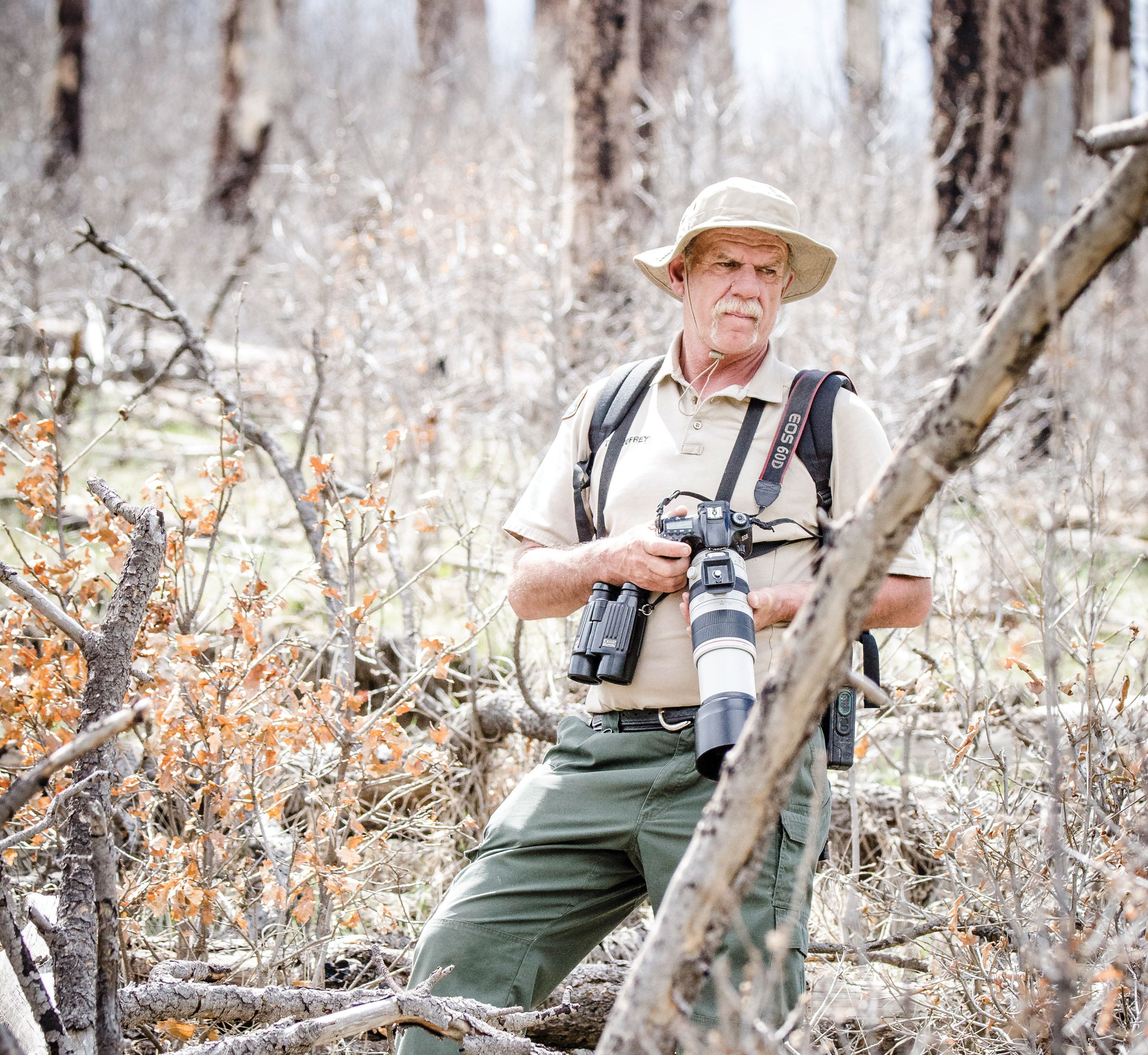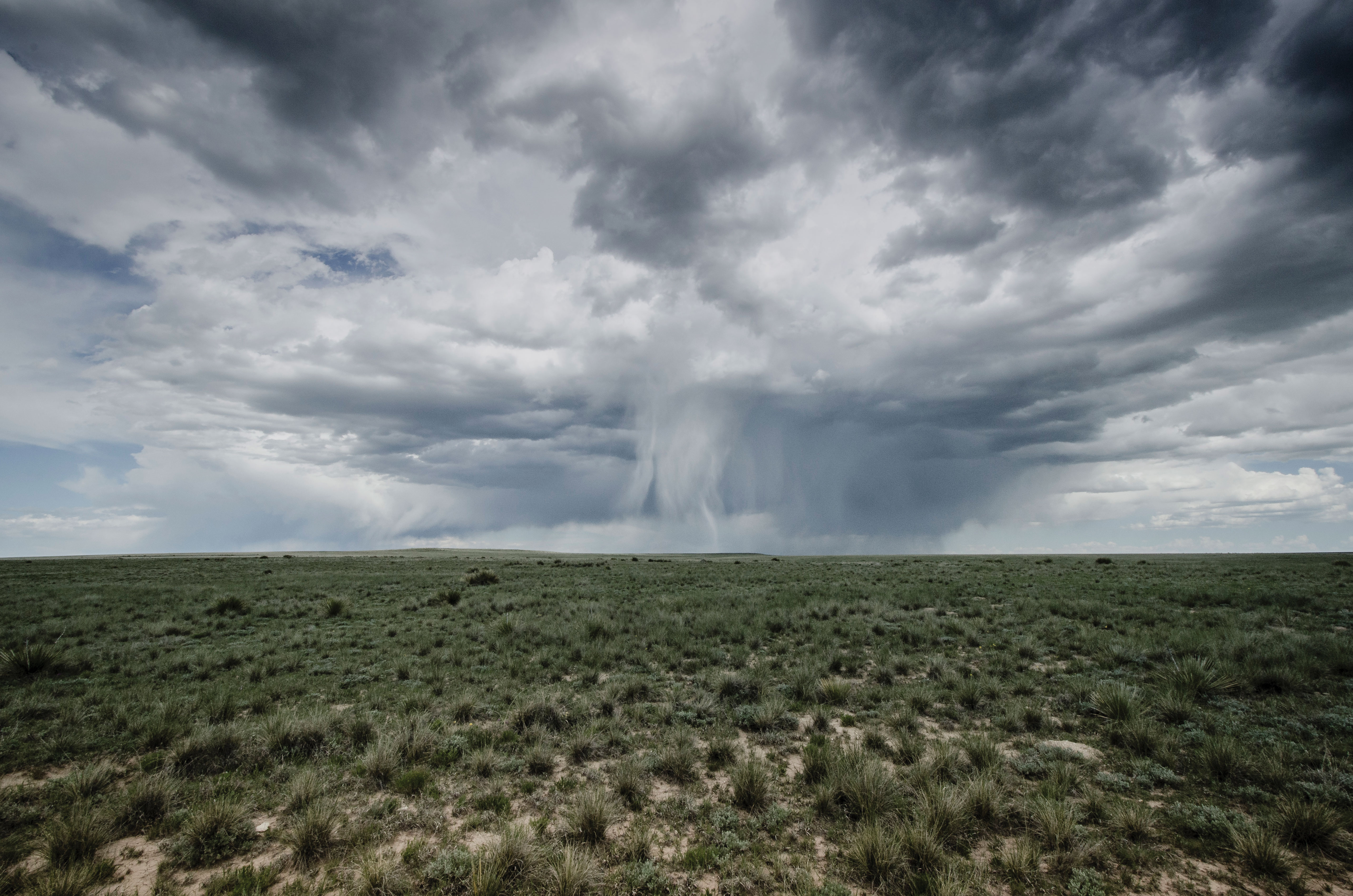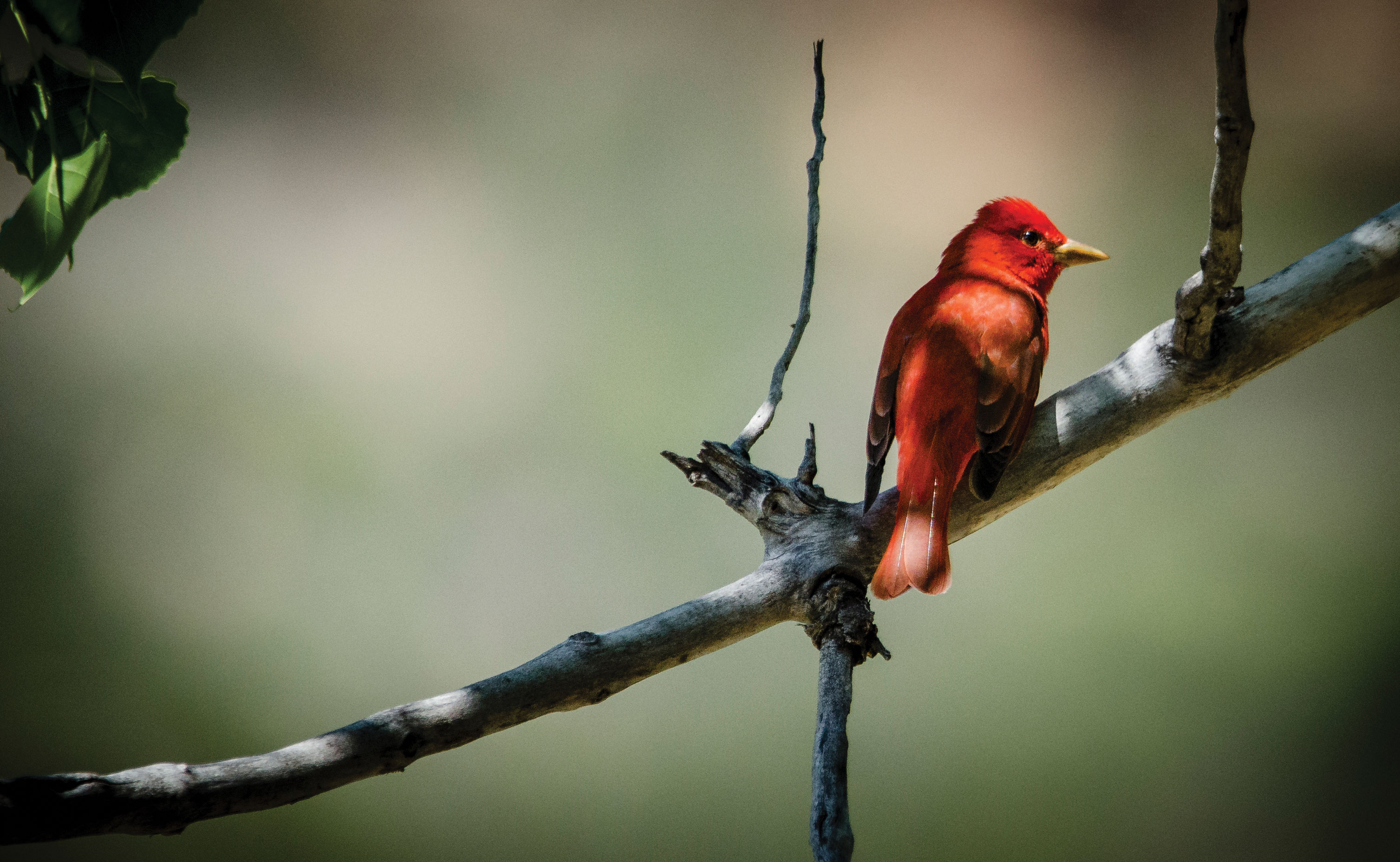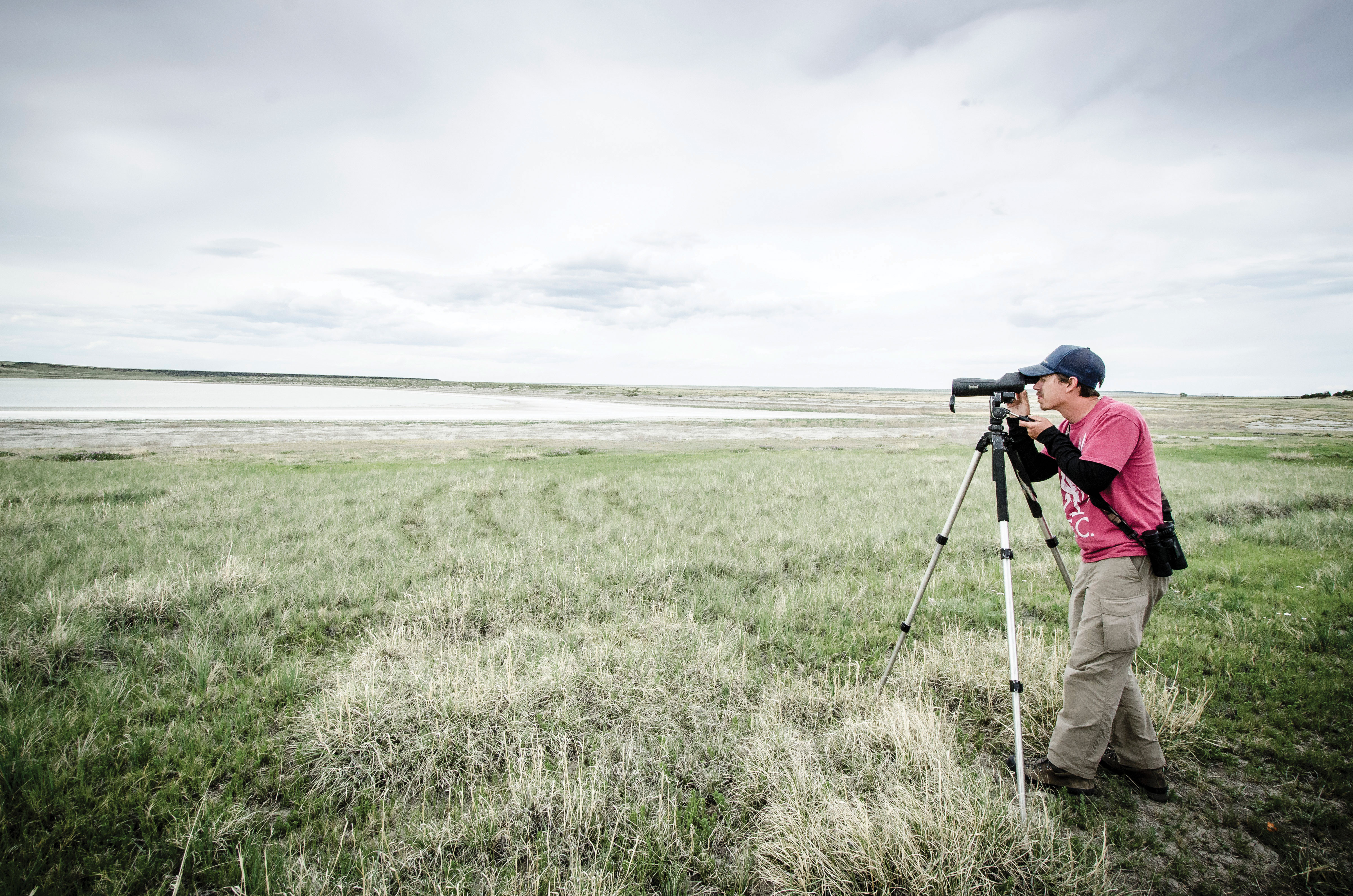Above: A Swainson's hawk at Maxwell National Wildlife Refuge. Photographs by Jim O'Donnell.
ON A BLUEBIRD MORNING IN MAY, Tony Godfrey pulls his pickup off a steep gravel road winding through a stand of ponderosa pines. The New Mexico State Parks ranger slings his Canon 60D over a shoulder and straps binoculars to his chest. Then he leads me to the rim of Mills Canyon, looking for a bright red bird. Actually, several bright red birds. And a blue one.
East of the historic village of Springer, in New Mexico’s northeastern corner, the mountains give way to shortgrass prairie that stretches to the sky. Fence lines run to the horizon. Here and there stands a tree or a cow. A windmill creaks in the breeze, slurping water from the aquifer below. Mills Canyon comes as a surprise. Amid the flat-out flatness, the canyon rim appears suddenly, the Canadian River running 1,000 feet below.
Godfrey and I trek across forested Cretaceous cliffs, then down through Jurassic and Triassic sandstone to a pool sheltered by a tilted cottonwood tree. Among a mist of dragonflies and damselflies we sit in the grass waiting for a summer tanager. And a hepatic tanager. “We’ll probably get a blue grosbeak too,” Godfrey says. And we do.
Around us, solitude reigns. While some of the better-known birding areas in the state, like the Bosque del Apache National Wildlife Refuge, invite elbow-to-elbow, lens-to-lens bird-watching, the northeast region stretches so far across seven counties that one rarely sees a fellow friend of a feathered friend. It’s become a bit of an open secret, albeit one that’s remote, vast, and diverse.
Godfrey, like any passionate birder, is somewhat obsessed with the place—and with birds in general. “May 15, 1975,” he says. On that day, his Nottingham, England, elementary school took a field trip to the famed Snowdon Aviary, at the London Zoo. Four hundred species circled him. “That’s when I knew I wanted to see the world. Birds changed my life.” After 19 years as a fireman in Arizona, he arrived in New Mexico. In 2013, he landed a position with New Mexico State Parks and is now based at Sugarite Canyon State Park, near Ratón.

Above: Tony Godfrey.
Over the next five hours, we cut down the canyon to the banks of the Canadian River, brimming with swift green water. Along the way, we count 37 species: vireos, tanagers, grosbeaks, wrens, warblers, orioles, woodpeckers, sparrows, swifts, swallows, and the yellow-breasted chat.
“The elevation change makes Mills unique,” says Godfrey. “You go from a montane environment on the rim to a desert environment at the bottom of the canyon. The elevation range means a bunch of different types of birds in a small area. Not something you find very often.”
Diversity is the key to the canyon’s rich birdlife. The landscape changes allow for a wide range of habitats with some 500 documented plant species—a smorgasbord of food sources to all kinds of animals.
Tens of millions of years ago, the seven counties that define northeastern New Mexico—Mora, Colfax, Union, Harding, San Miguel, Quay, and Guadalupe—were underwater. A shallow inland sea and coastal plain covered the region with colorful sedimentary deposits. These layer-cake-like alluvia were later cut, poked, cracked, and often capped by volcanic flows, dikes, and sills. The result is a complex landscape of rippling oceanic plains, haunting buttes, forested mesas, jungle-like river bottoms, hidden lakes, volcanic plugs, and truly endless skies. This is also the place where the mountains meet the plains. To our west, the Sangre de Cristo Mountains ascend to 12,000-to-13,000-foot peaks.
According to the Audubon Society of New Mexico, our state hosts more than 500 bird species. “We have the fourth-largest number of total bird species in the country,” says Cheryl Grindle, a freelance birding guide based in Santa Fe. “The seven northeastern counties host almost all of those species at one time or another throughout the year. The region is under-birded and certainly underreported.” And, says Godfrey, “totally underrated.”
THIS “IS WILD, OPEN COUNTRY,” Godfrey says. It’s open, for sure. But it isn’t totally wild. Small treasures tell of a time when the plains supported thousands of ranches and teeming tiny towns. Northeastern New Mexico is littered with diminutive fenced cemeteries, melting adobe farmhouses, archaeological truck frames, fallen windmills, and neat rows of elms planted in the 1930s to break the back of the winds that bend the prairie each spring. There were more people in northeastern New Mexico in 1900 than there are today. In places like Harding and Union Counties, there are currently more cows than people.
 Above: Walking rain sweeps the high plains, cooling the grasslands.
Above: Walking rain sweeps the high plains, cooling the grasslands.
And that makes this corner of New Mexico ripe for the adventurous birder. You will see very few other people, cell phone service can be sparse, food and gas are often 100 miles apart, and the weather might change at the drop of an umbrella, but birds abound.
Mills Canyon, today managed by the Cibola National Forest, isn’t what it once was. In 1881, Melvin Mills, a New Mexico lawyer, planted some 14,000 fruit and nut trees along the river bottom. Between 1881 and 1912, thousands of tons of peaches, pears, plums, cherries, apricots, and almonds were hauled from the canyon by wagon to market in the surrounding communities. Today, Mills’ abandoned offices and the old stagecoach station are home to violet-green swallows, white-throated swifts, and western screech owls.
Godfrey, Grindle, and others are looking to showcase the ecological wealth of the seven-county region to attract more birders—and their tourism dollars. This ad hoc group of state and local officials, business owners, and avian aficionados are soon to publish the Birding and Nature Trail Guide to Northeast New Mexico, which aims to capture some of the $41 billion that bird-watching brings each year to the American economy.
“Here we have this huge opportunity in the birds. How can we protect this priceless resource and improve habitat while supporting local communities and enhancing our economy?” says Kim Allen, owner of Pecos River Cabins, a collection of compact cottages that is quickly becoming a destination for bird-watching visitors to the region. “Our area is ripe for birding tourism.”
Birding here peaks from March through mid-October, but Grindle insists there is no bad time to bird the region. Winter, she says, brings waterbirds such as snow geese, sandhill cranes, and common goldeneyes, and raptors such as bald eagles to places like the Las Vegas and Maxwell National Wildlife Refuges.
 Above: A summer tanager spotted in Mills Canyon.
Above: A summer tanager spotted in Mills Canyon.
“Birding is accessible to everyone. You don’t have to climb Mount Everest to see birds. I mean, you can, but you don’t have to,” Allen says with a laugh. “Birding is available to kids and grandparents too.”
“ONE THING I LIKE TO DO,” says Will Jaremko-Wright, “is get on Google Maps and find the places where a road crosses a creek or a river or runs up against a playa. Then I load up and plan my birding route for those stops.”
A playa is an ephemeral lake, one that comes and goes depending on moisture. Much of the best birding in the region happens at these chimeric water bodies. I meet up with Jaremko-Wright at Elida’s Café, in Springer. He’s an instructor of natural resource management at New Mexico Highlands University, in Las Vegas, and a passionate birder. His Honda has a bedroll in the back and is adorned with bumper stickers for the eBird app and his favorite ski areas. “I spend weeks all alone sometimes, just looking for birds,” he says.
After a healthy portion of huevos rancheros, we push east toward the town of Clayton, along the way birding tree stands that mark old homesteads and bridges over willowed and muddy creeks. At one crossing along the Canadian River, we count twenty-some species in about 10 minutes—cliff swallows, violet-green swallows, a blue grosbeak, yellow warbler, yellow-breasted chat, lark sparrow, blue heron, brown-headed cowbird, and MacGillivray’s warbler among them. The bubbling, watery call of the red-winged blackbird accompanies our search.
“The Canadian River is incredible habitat,” Jaremko-Wright says. “It’s wet and it marks the eastern edge of the shift between the mountains and the plains. So you get all kinds of stuff.”
One playa, a white expanse of calcium and salts, sits at the edge of a five-million-year-old lava flow. Springs seeping from the basalt feed pockets of cottonwood and grass, ultimately filling a wide, shallow playa. As evening approaches, Jaremko-Wright helps me identify gadwalls, American avocets, snowy plovers, semipalmated plovers, killdeers, and Baird’s sandpipers—shorebirds I didn’t expect to see in the shadows of mountains where it snowed just a few days ago.
 Above: A broad-tailed hummingbird spotted in Terrero.
Above: A broad-tailed hummingbird spotted in Terrero.
But where water gathers in the high desert, magic happens.
THERE ARE THE PLAINS, MESAS, volcanic escarpments, playas, lakes, and river bottoms. Then there are the alpine canyons. One chilly morning in May, Allen serves up breakfast burritos stuffed with green chile while we watch an orange male oriole dangle from a hummingbird feeder. Allen has invited me to her riverside retreat to talk about birding in the canyons that spill from the conifer-dressed peaks of the Pecos Wilderness Area. Cheryl Grindle, who’s kindly joined us, leads the way up the canyon, despite having one foot in a cast.
Pecos River Cabins is the perfect jumping-off point for birders. Located within the riparian forest just a mile from the village of Pecos, Allen’s cabins sit in a shady, flower-filled oasis. Her website brags: “Many of our birding guests obtain multiple Lifers on property.” (“Lifer” meaning any species a particular birder has never seen before. Yes, they keep track.) Accompanied by the rumbling thunder of a cresting Pecos River, Grindle leads us on a 30-minute tour during which we identify nearly two dozen species. Thanks to this richness, Allen has started to market her cabins to birders who want to learn from Grindle’s expertise and attend evening lectures. After scoping the property, we jump in our cars and follow the river into the mountains.
Pecos Canyon has five ecological zones: piñon/juniper, riparian, mixed conifer dominated by ponderosa pine, subalpine, and alpine. “You can get different species every 1,000 feet,” says Grindle, and she lists the types she expects us to see today: Grace’s warbler, Virginia’s warbler, Williamson’s sapsucker, pygmy nuthatch, Bullock’s oriole, black phoebe, Steller’s jay, yellow warbler, dusky grouse, northern goshawk, western tanager, red-naped sapsucker, northern flicker, ruby-crowned kinglet, and the American dipper, which breeds along the river. “Each canyon along the front range has its own personality and oftentimes its own species,” she says.
The steep incline of Pecos Canyon isn’t the only place to find this kind of abrupt habitat change. On a windy Wednesday, I meet Tony Godfrey at the Sugarite Canyon State Park visitor center. A school group romps across the lawn, families come and go from the interpretive center, hummingbirds swarm the feeders, and blackbirds pick at seeds the rangers have set in front of the stone building.
Godfrey and I hike up Chicorica Creek to a cascading beaver dam. The rodents’ pond mirrors the sky. The beavers profoundly impact the landscape through flood control, aquifer recharge, and creation of fish habitat, as well as by filtering sediments and pollutants from the water and forming the perfect conditions for a wide variety of birds.
“We got a Pacific wren up here last winter,” says Godfrey. “It was the first recorded sighting in this part of New Mexico. We also had two species of rosy finches. Birders came from all over to see them.” As we watch an American dipper rock-hop, a belted kingfisher darts past. A beaver swims over, curious. Then, unimpressed, disappears below the looking-glass pool.
 Above: Will Jaremko-Wright scouts one of the hundred playas dotting the region.
Above: Will Jaremko-Wright scouts one of the hundred playas dotting the region.
After this particular day, I keep coming back. From my home in Taos, it takes less than two hours to cross the mountains and land myself on the plains. I aim to hit as many birding locations as I can. Maxwell, Clayton, Pecos Canyon, Sugarite, Mills … At some point it occurs to me that there is a lifetime of bird-watching to be had in this part of the state. I’ll never see it all.
One morning, Will Jaremko-Wright rouses me from my slumber before dawn and shoves a warm cup of coffee into my hands. “It’s hard to find a good cup of coffee at five o’clock in the morning,” he says. He leads me north from Las Vegas to the Rio Mora National Wildlife Refuge. The sky is smeared with lenticular clouds portending a gusty spring day. Dawn yellows the eastern blue.
Jaremko-Wright conducts a regular avian survey for the Denver Zoo, a partner in managing this 4,224-acre chunk of federal land. The refuge is dominated by the dense willow thickets and cottonwood stands of the snowmelt-fed Río Mora. The river cuts a 200-to-300-foot canyon through the prairie and groves of piñon and juniper. Like Godfrey and Grindle (and unlike me), Jaremko-Wright can identify birds simply by their calls or songs. At each stop along the survey routes, he records species I can’t even find with my giant camera lens.
Sometimes, though, it’s not just about the birds. At one point, Jaremko-Wright pauses. He holds a finger to his lips, then points into the wilds. A beaver slaps its tail on the water in warning. A woodpecker whinnies. A morning breeze shudders the tops of the cottonwoods.
“You see?” he says, softly. “When you’re on the land, paying attention, it makes you more conscientious of the world around you—not to mention your place in the world.”

FOR THE BIRDS
Bird-watching in the northeast takes wing with these amenities.
Guides: Bill West, of Wings West Birding, and Cheryl Grindle, of the Bird Hub.
Base Camps: Lodgings abound in the region. My favorites: Microtel Inn and Suites, in Ratón, and Pecos River Cabins, near the village of Pecos.
More Info: Audubon New Mexico has chapters around the state with birding tips, outreach events, and materials to help identify and photograph birds. Keep an eye out for the soon-to-be-published Birding and Nature Trail Guide to Northeast New Mexico. —JO
NORTHEASTERN NEW MEXICO BIRDING HOT SPOTS
- Cimarrón Canyon State Park
- Clayton Lake State Park
- Eagle Nest Lake State Park
- Maxwell National Wildlife Refuge
- Pecos Canyon
- Sugarite Canyon State Park
- Las Vegas National Wildlife Refuge
- Mills Canyon
- Ute Lake State Park
- Charette Lakes Fishing Area —JO


